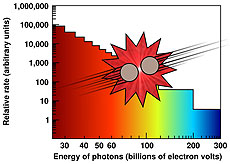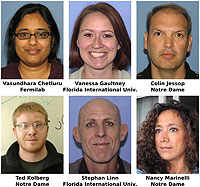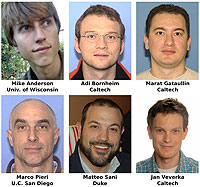The color of collisions
 |
|
The photons measured by CMS differ from visible light only in energy: light that we see has 2-3 electron-volts per photon, while photons from the LHC have billions of electron-volts.
|
When protons collide in the LHC, they sometimes emit a flash of light. Light is made of particles called photons, and the energy of the photons determines the color of the light. Red light is approximately 2 electron volts (eV) while blue light is about 3 eV, with all visible colors in between. Photons that are more energetic than blue light are usually called ultraviolet (100 eV), X-rays (10 thousand eV) and gamma rays (100 thousand eV or more). Many of the photons produced in LHC collisions have 30 billion to 300 billion electron volts (GeV).
CMS scientists recently measured the color of LHC collisions. That is, they measured the energy of each photon as it emerged from the collision debris and plotted the distribution of all of them. The figure above shows what that distribution looks like: Most of the measured photons have an energy of 30 GeV, with fewer and fewer at higher energies. One could say that the collisions are reddish, if the whole distribution were scaled down to the visible range.
Why is this interesting? Photons are unaffected by all of the other particles in the collision debris, so they let us see the first instant of collision. Most of the particles in the debris are hadrons such as pions, kaons, etas and rhos—the so-called particle zoo. Hadrons are made from coalescing quarks and gluons. This process changes their trajectories after the collision and hides their initial energies. Photons from the initial collision, however, stream directly into the CMS electromagnetic calorimeter to be measured. These measurements quantify the accuracy of current quark collision models, which are used in nearly all interpretations of LHC data.
The photons studied in this analysis are also the background noise that scientists need to sift through to search for a Higgs boson, assuming that it is hiding in the parameter range that is not yet ruled out. A Higgs boson can decay into two photons with a very narrow range of energy, like a pure but faint color in a ruddy mix of hues.
—Jim Pivarski
 |
| The U.S. physicists pictured above contributed to this analysis of the photon energy spectrum.
|
 |
|
The above physicists work to help identify photons and characterize the detector's performance in ways that are directly applicable to this analysis. They are part of a much larger photon identification effort. |
|